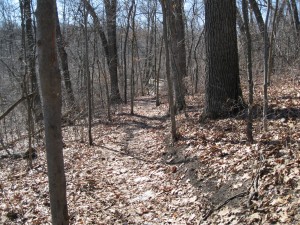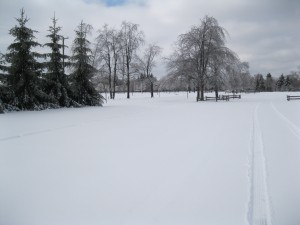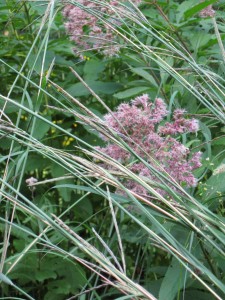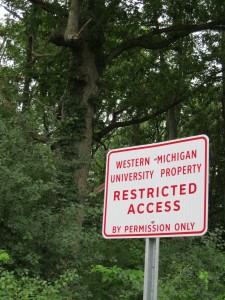Following is a slightly revised version of a letter that I sent to members of the Calhoun County Board of Commissioners on 29 April 2011. They will soon (Thursday, 7 April, 7 PM at the County Building, 315 West Green St. in Marshall) be taking an important vote related to whether the Calhoun County Trailways Association will be permitted to run a wide, bituminous bicycle trail through the preserve.

Fringed gentian in fen at Harvey Ott Preserve, Calhoun County. Photo September 1994 by Richard Brewer
I first learned of the Harvey Ott Biological Preserve about 1967 from the study of the preserve’s forests by Tony Catana, then in the Biology Department at Albion College. I have visited the preserve a good many times since, most frequently in the period after the timber cutting regrettably authorized by an earlier Calhoun County Board of Commissioners. In September 1994, I brought my ecology class from Western Michigan University to study the destruction, and over the next several months, directed a detailed study of the logged site by a graduate student. In 1994 and 1995 I sat in on some of the meetings of the ad hoc committee that produced a management plan and policies for the preserve. The plan and policies that were developed weren’t bad. They would make a good starting place for a stricter and more comprehensive document for the future.
My opinion is that a bicycle trail of any sort, let alone a wide asphalt trail, would be harmful to the native plants, animals, and ecosystems of the site. Damage would come from construction and would continue during later use of the trail.
I also believe that such an intrusion is contrary to stated aims for the preserve in every stage of its history and under every owner. This includes ownership by Calhoun County. To finance purchasing the preserve from Albion College, the County applied for a federal Land and Water Conservation Fund grant. Its application stated, “The property was originally purchased by Battle Creek College for a nature-biological study area. The full intent of Calhoun County is to continue with the preservation….” The Site Management Plan prepared by the ad hoc committee in 1994-1995 stated, “It is the intent of Calhoun County to maintain the Preserve as an area for passive, non-destructive, recreational, educational, and aesthetic use.” In the Plan, bicycling (and horseback riding, among other things) is specifically prohibited.
In my opinion the plan brought forth by the Trailways Alliance was not well designed. It’s hard to believe that the group has spent eight years planning and promoting the trail without doing environmental due diligence. Not only have no studies of the Ott Preserve been done, but it appears that no studies have been done anywhere along the proposed route. What rare plants or animals or important natural features will be impacted? But also, what contaminated or otherwise dangerous sites would the projected route take hikers through?
I am a supporter of trails. Rail-trail conversions around the nation have nearly always been environmentally and socially beneficial. The same can be said about many other sorts of trails–trails that were thoughtfully routed, carefully designed, and competently executed. I do not consider trails that invade preserved natural areas to be in this category. In fact, designing a trail by poaching on protected public or other conservation lands seems to me a disservice to the citizens of the region– as well as showing a certain lack of initiative. Optimal trail design would include, among other criteria, a route that eliminates or minimizes damage to preserves, parks, and other sensitive areas.
If the choice is between a hard-surfaced trail running through the preserve and no trail, then no trail is the responsible choice without question.
The only compromise I can see that would be respectful of the values of the preserve and meet the clear duty of Calhoun County as stewards of the preserve would be a trail that stopped outside the preserve, perhaps at a bicycle-parking area, also outside the preserve. From the bicycle-parking area, a short foot trail to the preserve boundary could allow access to the foot trails of the preserve. Providing a way to get to the Ott Preserve without the use of a car is one good feature of the Trailways plan and probably worthy of retaining–but only if the preserve itself is absolutely protected.
Additional comments: My impression is that the Calhoun County Board has done a good job of listening. Perhaps they will adopt some sort of compromise position. But there are an infinite number of possible routes between the northwest parking lot of the Ott Preserve and the stoplight on Michigan Avenue (route mentioned in 12.A in the Commission agenda for 7 April 2011). Some of these might be almost totally protective of the Ott and some might be damaging. It would be desirable that the route to be taken should be nailed down and described in any resolution adopted in the April 7 meeting. Also spelled out should be the principles to be followed for any trail section where the precise route can’t be currently stated (for example, no alteration of existing land contours).
These requirements are essential considering that any construction is likely to be some little time away, probably several years. Public memories dim. The trail advocates have fought doggedly for their vision of a 14-foot-wide bicycle path down the middle of the Ott. When construction begins, three or four or five years from now, a strong pull could exist toward dealing with any ambiguities in the statement of route by following the “bicycle-trail-through-the-Ott” game plan familiar to the Trailway Alliance and its allies in county government.










